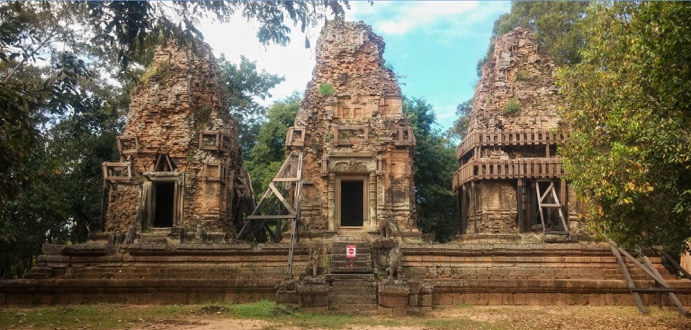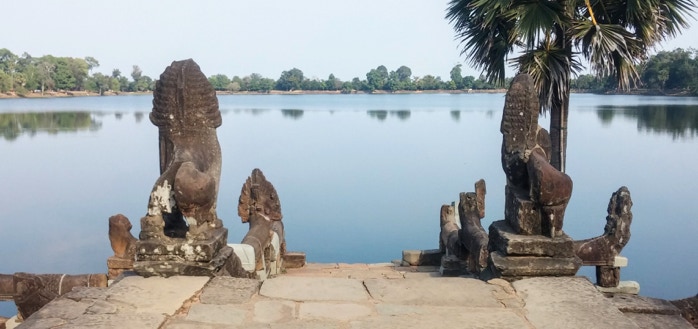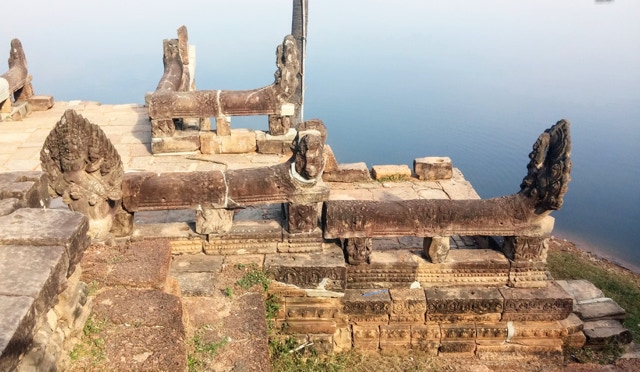BAT
CHUM
(960)

BAT
CHUM
(960)

Kavindrarimathana, the architect of East Mebon (953) and Pre Rup (961) and only Angkorian sthapaka whose name we know, was held in such esteem by Rajendravarman that he was granted the extraordinary privilege of building his own temple for his Buddhist faith, despite the Khmer’s Saivite state religion as enshrined in the devaraja cult. Bat Chum is an architecturally modest and neglected group of three towers on a common base like the earlier Prasat Bei (915-928) or the five more distinguished towers of Prasat Karvan located just across the road. The fact that Kavindrarimathana adopted the standard Khmer shrine module rather than a more explicitly Buddhist form such as a stupa suggests discretion or Angkorian syncretism which tended to see all religions as somehow interchangeable. A vihear (Sans. > dwelling, refuge, hermitage) for the resident monks was included with this temple complex as was a reservoir or baray (see the two photos below); like all domestic architecture at Angkor, this dormitory was built of wood and has decayed in the tropical climate.
These three prasats were dedicated to the Mahayana Buddhist trinity. The central shrine honored the historical Buddha, Sakyamuni; the northern was consecrated to Prajnaparamita, the bodhisattva of wisdom, specifically the highest paramita, attainment or perfection - "non-attachment," the mental tranquility (or numbness) arising from an awareness of sunyata, the "emptiness" of all thought. (The ten paramitas required of a bodhisattva are summarized in appendix III;) finally, the southern shrine was reserved for Avalokiteshvara (Kh. > Lokesvara,) the popular bodhisattva of compassion who Jayavarman VII, two centuries later, would identify with his father and a perennial candidate for the face towers of the Bayon. At Bat Chum, however, he was worshipped in his more aggressive aspect, Vajrapani, the powerful protector of dharma, through his indomitable tathagata, "givenness" or "suchness," defined as "he who neither comes or goes, who neither originates or ceases." The presence of an active Buddhist temple and monastery at Angkor as early as the mid-10th Century suggests that Mahayana and Vajrayana schools had a presence at the Khmer court over much of its history.
The dedicatory plaque at Bat Chum provides insight into daily religious and secular life at Angkor. It praises Kavindrarimathana for his construction of the Srah Srang Baray, providing clear water for the people, while not mentioning any use for irrigation. It has imprecations against "dike-breakers," either untethered elephants or riders of elephants on top of the levees, apparently the betes noirs of Angkorian engineers. It also restricts use of the temple's "tank" or pool to Buddhist monks as well as Hindu brahmins, affording them equal status. This inscription has been cited as evidence that Buddhist monks might have played some part in the devaraja abhiseka or "empowerment ceremony," a ritual similar to initiation into monastic Buddhist orders and paramparas or guru lineages.
SRAH
SRANG
(c.961)

LOOKING EAST, SRAH SRANG (C.961)
The small Srah Srang Baray, only 350m x750m, seems to have been another personal project of Rajendravarman's architect, Kavindrarimarhana, which would have supplied water for his nearby Buddhist temple, Bat Chum. Much later Jayavarman VII's (1181-1220) sited his third large Buddhist foundation, Banteay Kdei, with its east-west "liturgical" axis aligned with this baray on what is thought to have been the site of an earlier 10th Century temple, probably constructed by the same sthapaka. The proximity of that Buddhist monarch's third monastery to its modest predecessor, Bat Chum, was probably no coincidence.
Jayavarman VII built this landing stage with naga railings and lions regnant or chinthes to provide dignified access to his new foundation, Banteay Kdei, for the Angkorian elite who apparently preferred to travel through the area's network of canals rather than on "dike breakers" (elephants.) This quay or dock takes the familiar form of a "rainbow" or naga bridge, symbolizing for the Khmer a purifying passage over water from the profane to sacred. Less than 500m west of here, a second spacious bridge, also with nagas and leogryphs, crosses the moat of Banteay Kdei through its 3rd east gopura into the monastery's inner sanctum. In 1191 Jayavarman VII dedicated an even more ambitious monastery north of here,with its own baray to the memory of his father.

THE LANDING STAGE, SRAR SRANG (1181-1120)
52